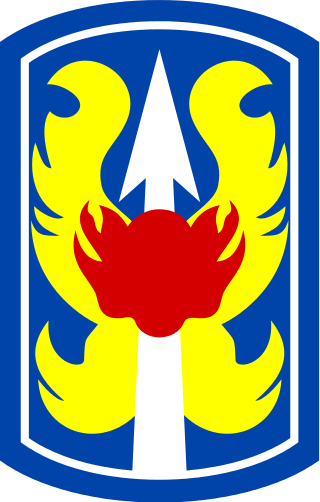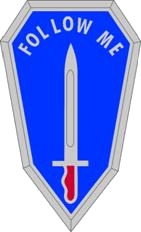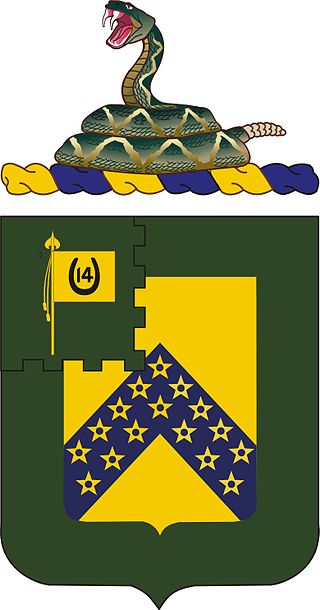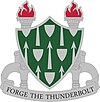
The 2nd Armored Division was an armored division of the United States Army. The division played important roles during World War II in the invasions of Germany, North Africa, and Sicily and in the liberation of France, Belgium, and the Netherlands. During the Cold War, the division was primarily based at Fort Hood, Texas, and had a reinforced brigade forward stationed in Garlstedt, West Germany. After participation in the Persian Gulf War, the division was inactivated in 1995.

The Stryker is a family of eight-wheeled armored fighting vehicles derived from the Canadian LAV III. Stryker vehicles are produced by General Dynamics Land Systems-Canada (GDLS-C) for the United States Army in a plant in London, Ontario. It has four-wheel drive (8×4) and can be switched to all-wheel drive (8×8).

Fort Moore is a United States Army post near Columbus, Georgia, adjacent to the Alabama–Georgia border. Fort Moore supports more than 120,000 active-duty military, family members, reserve component soldiers, retirees and civilian employees on a daily basis. As a power projection platform, the post can deploy combat-ready forces by air, rail, and highway for their designated mission. Fort Moore is the home of the United States Army Maneuver Center of Excellence, the United States Army Armor School, United States Army Infantry School, the Western Hemisphere Institute for Security Cooperation, elements of the 75th Ranger Regiment, the 1st Security Force Assistance Brigade, and other tenant units.

Kenneth O. Preston is a retired United States Army soldier who served as the Sergeant Major of the Army. He was sworn in as the 13th Sergeant Major of the Army on January 15, 2004. Preston served 7 years and 2 months as Sergeant Major of the Army making him the longest serving Sergeant Major of the Army to date.

Camp Shelby is a military post whose South Gate is located at the southern boundary of Hattiesburg, Mississippi, on U.S. Highway 49. It is the largest state-owned training site in the nation. During wartime, the camp's mission is to serve as a major independent mobilization station of the United States Army Forces Command (FORSCOM). Camp Shelby Joint Forces Training Center is the largest reserve component training site, covering 136,000 acres (550 km2), allowing up to battalion-level maneuver training, Gunnery Table 8-12, field artillery firing points and a wide range of support facilities. This is the normal Annual Training location for National Guard and Reserve units located in Mississippi, Alabama, and Tennessee. However, units from across the country use its assets to support a variety of missions. The 2nd Battalion, 114th Field Artillery conducts its gunnery training and has the bulk of its combat equipment stored in the Mobilization and Annual Training Equipment Site (MATES) located there.

The brigade combat team (BCT) is the basic deployable unit of maneuver in the U.S. Army. A brigade combat team consists of one combat arms branch maneuver brigade, and its assigned support and fire units. A brigade is normally commanded by a colonel (O-6) although in some cases a brigadier general (O-7) may assume command. A brigade combat team contains combat support and combat service support units necessary to sustain its operations. BCTs contain organic artillery training and support, received from the parent division artillery (DIVARTY). There are three types of brigade combat teams: infantry, Stryker, and armored.
Reconnaissance, surveillance, and target acquisition (RSTA) refers to a joint doctrine of reconnaissance, surveillance and target acquisition conducted by the United States Armed Forces. RSTA operations are designed to support military operations at a strategic, operational, or tactical level, either by dedicated RSTA forces or those which possess the capability.

United States Army Reconnaissance and Surveillance Leaders Course (RSLC) is a 29-day school designed on mastering reconnaissance fundamentals of officers and non-commissioned officers eligible for assignments to those units whose primary mission is to conduct reconnaissance and surveillance, target acquisition, and combat assessment operations. RSLC is taught by the 4th Ranger Training Battalion, Airborne and Ranger Training Brigade. The school is open to Soldiers, Marines, Sailors and Airmen to train them to expert levels in reconnaissance, surveillance, target acquisition, battle damage assessment, communications, planning, foreign vehicle identification, and other skills. The school was originally created to serve leaders from Long Range Surveillance Units (LRSU's), but now provides the specific reconnaissance training needed to ensure the effectiveness of small unit reconnaissance elements for the U.S. Army and joint force. Given the training focus and difficulty of the RSLC, the school is still commonly attended by operators from U.S. Army Special Forces, the 75th Ranger Regiment's Regimental Reconnaissance Company, U.S. Army Civil Affairs, Navy SEALs, and Marine reconnaissance units; today's students also come from more conventional infantry, Stryker and armored Brigade Combat Teams (BCT). Following the US Army decision to disband US Army LRS companies, the reconnaissance fundamentals taught in the course also provides U.S. military commanders the ability to preserve key LRS skills and abilities within the conventional force.
Master gunner is an appointment of the warrant officer rank in the British and United States armed forces.

The 199th Infantry Brigade (Light) is a unit of the United States Army which served in the Army Reserve from 1921 to 1940, in the active army from 1966 to 1970 (serving in the Vietnam War), briefly in 1991–1992 at Fort Lewis, and from 2007 as an active army training formation at Fort Moore.

Cavalry Scout is the job title of someone who has achieved the military occupational specialty of 19D Armored Reconnaissance Specialist in the Combat Arms branch of the United States Army. As with all enlisted soldiers in the United States Cavalry, the person holding the Scout specialization will still be referred to as a "Trooper", the traditional colloquialism denoted in the cavalry's Order of the Spur.

The United States Army Infantry School is a school located at Fort Moore, Georgia that is dedicated to training infantrymen for service in the United States Army.

The M1128 Mobile Gun System (MGS) is an eight-wheeled assault gun of the Stryker family, mounting a 105 mm tank gun, based on the Canadian LAV III light-armored vehicle manufactured by General Dynamics Land Systems for the U.S. Army.

The 197th Infantry Brigade is an active Infantry brigade of the United States Army. The brigade was active as an Organized Reserve unit from 1921 to 1942, in the Regular Army from 1962 to 1991, and as a TRADOC training unit from 2007 to 2013. The brigade saw service in Operation Desert Storm with the 24th Infantry Division. On July 31, 2020, the brigade was activated as a training brigade in Fort Moore, Georgia, to serve the increased training needs of the army.

The structure of the United States Army is complex, and can be interpreted in several different ways: active/reserve, operational/administrative, and branches/functional areas.

The 316th Cavalry Brigade of the United States Army is the brigade responsible for the training of U.S. Army Cavalry and Armor officers and non-commissioned officers. The 16th Cavalry Regiment was redesignated as this unit in July 2010. The 316th Cavalry Brigade is currently assigned to Fort Moore, Georgia, in accordance with the Base Realignment and Closure of 2005.

The Armor Branch of the United States Army is an active armored warfare combat arms branch.

The 16th Cavalry Regiment is a Regiment of the United States Army first established in 1916. Currently the regiment includes three squadrons, all assigned to the 316th Cavalry Brigade, Fort Benning, Georgia, supporting the United States Army Armor School.

Excellence in Armor (EIA) is a program of the United States Army Training and Doctrine Command that awards outstanding Armor and Cavalry Soldiers whose performance is routinely above the standard and demonstrate superior leadership potential. The EIA was initially proposed in May 1984 and implemented in October 1987. The program rewards outstanding armor and cavalry soldiers with a Certificate of Achievement, a challenge coin from the U.S. Army's Chief of Armor, awarding of the personnel development skill identifier (PDSI) “E4J,” and will set the soldier apart from their peers during promotion boards.

The United States Army's Master Gunner Identification Badge (MGIB) recognizes soldiers who complete one of eight U.S. Army master gunner courses and is an indicator for commanders and soldiers to value the master gunner's advice regarding the training and employment of weapon systems.
























